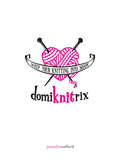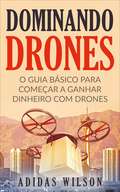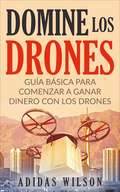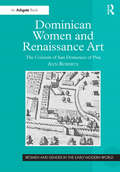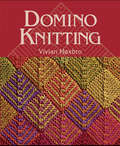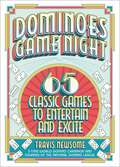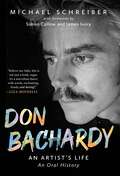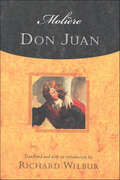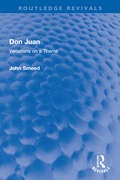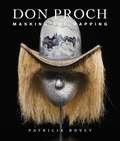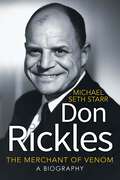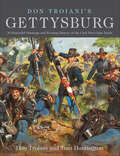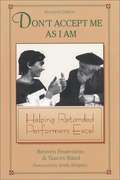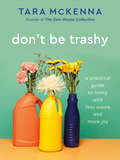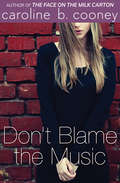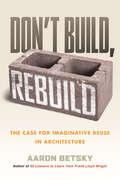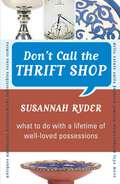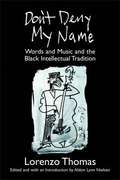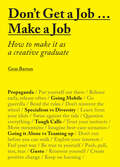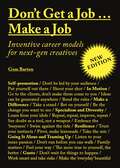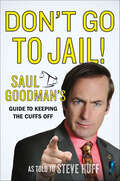- Table View
- List View
Domiknitrix: Whip Your Knitting Into Shape
by Jennifer StaffordWhip Your Knitting into Shape do#149;mi#149;kni#149;trix\ da-mi-'ni-triks \ n, pl -trices [US, var. of dominatrix, re: knitting] (2005): a woman who dominates her knitting; broadly: a badass knitter You have knitted your last bad piece. Let theDomiKNITrixshow you the ropes. Yes, it may be painful to take the time to knit a gauge swatch, count stitches and fix mistakes. But just think of the pleasure you'll get when you knit a gorgeous, perfect sweater with no holes and no uneven stitches. Learn the rules or else. Inside you'll find a no-nonsense, comprehensive guide to essential knitting operations and finishing techniques, including step-by-step instructions for all the basic stitches used in the patterns in the book. Get your hands dirty. The book features over 20 spicy projects to satisfy any knitting appetite. For a Knitting Quickie, choose from one of the smaller projects, such as the Mohawk hat or the popular Snow Devil cap. If you want more of a challenge, try the L'il Red Riding Hoodie or the Big Bad Wolf icon sweater, The Slink or City Coat.
Dominando Drones: O Guia Básico para Começar a Ganhar Dinheiro com Drones
by Adidas WilsonEstas informações são a razão pela qual escrevi este livro. De acordo com minhas pesquisas, o ano de 2015 será marcante para os drones. Agora é a hora de empreender para ganhar dinheiro com estes dispositivos. Drones comerciais e seus serviços devem se tornar uma indústria multibilionária na próxima década, de acordo com um novo relatório da empresa de inteligência de mercado Tractica. O relatório diz que, em 2017, a receita de drones deve totalizar US$ 792 milhões - principalmente com vendas de hardware. Até 2025, a Tractica prevê que o mercado aumentará para US$ 12,6 bilhões, com dois terços da receita proveniente de serviços baseados em drones e não de hardware. "Várias indústrias importantes estão vendo futuro na utilização de drones para uso comercial", diz Manoj Sahi, analista de pesquisa da Tractica. Ele citou a mídia, o setor imobiliário e a assistência a desastres como apenas alguns dos setores que poderiam usar serviços habilitados para drones. O relatório afirma que os avanços tecnológicos, as economias de escala, os aplicativos baseados em nuvem e o desejo de romper com o mercado contribuirão para o sucesso comercial dos drones nos próximos anos.
Dominar Apple TV 4K: Guía de usuario definitiva para Apple TV con Siri
by Adidas WilsonCuando usted escucha hablar de Apple TV inmediatamente piensa que lo que usted está comprando es una TV Real. Pero no es el caso. La Apple TV es un dispositivo que usted utilizará realmente para que le transmita algo y que es parecido al Fire de Amazon o al Roku. Es una pequeña caja negra de alrededor de una pulgada y media de alto, y sólo un poco menos que cuatro pulgadas, que funciona en una plataforma muy similar al iPad y los populares iPhones. Usted puede descargar una lista de apps y además juegos más allá de la transmisión standard de video que usted podría obtener desde Hulu, Netflix y Amazon por solamente nombrar algunos. La Apple TV ha sido centrada en varias apps, y todavía es capaz de transmitir múltiples shows de TV, y películas directamente en su HDTV, pero esto es solamente la punta del iceberg de las características con las que esta caja ha sido fabricada. La caja le permite a usted ver y transmitir podcasts, jugar a su juego favorito, transmitir su lista de ejercicios, y mucho más. Pero lo que es importante notar, para disfrutar de todos estos beneficios con los que esta caja está lista para proveerle es que todo dependerá de las apps que usted haya instalado. Algunas de las apps que usted utilizará son gratis, y algunas le costarán. Piénselo de esta manera; la Apple TV es capaz de transformar a su TV en una Smart TV. Incluso puede rentar sus películas favoritas o solamente transmitir su colección desde su cuenta de iTunes. Además puede transmitir shows de películas desde apps como Hulu Plus o Netflix; transmitir su música desde las apps de Pandora o Apple Music. Quiero decir que la lista es interminable en aquello que la Apple TV puede hacer por usted. La Apple TV 4K ha sido diseñada con algunos de los procesadores más rápidos que usted pueda encontrar, los mismos que alimentan al iPad Pro. La caja de Apple TV ha sido hecho para ser tan poderosa como la mayoría de las laptops que utilizamos. Además posee un procesador g
Domine Los Drones, Guía Básica para Comenzar a Ganar Dinero con los Drones
by Adidas WilsonSe espera que los drones comerciales y sus servicios se conviertan en una industria multibillonaria en la próxima década, de acuerdo con un nuevo informe de la firma de inteligencia de mercados Tractica. El informe indica que en 2017 los ingresos generados por los drones deben llegar a aproximadamente US$792 millones, principalmente por ventas de equipos. Para 2025, Tractica predice que este mercado crecerá hasta alcanzar US$12.600 millones, donde las dos terceras partes de estos ingresos vendrán más de servicios prestados por drones que de ventas de equipos. “Hay varias industrias importantes que están viendo fuertes propuestas de valor en la utilización de drones para uso comercial” dice Manoj Sahi, analista de investigación de Tractica. El nombra a los medios, los bienes raíces y la asistencia a casos de desastres, como solo algunas de las industrias que podrían usar servicios prestados por drones. El informe dice que los avances en la tecnología, las economías de escala, las aplicaciones basadas en la nube y el deseo de trastornar el mercado contribuirán al éxito comercial de los drones en los próximos años.
Dominican Women and Renaissance Art: The Convent of San Domenico of Pisa (Women and Gender in the Early Modern World)
by Ann RobertsStarting from an inventory and other documents, Ann Roberts has identified some 30 works of art that originated from the convent of San Domenico of Pisa. She here examines those objects commissioned for and made by the nuns during the fifteenth century; some of the objects included have never before been published. One of her goals in this study is to bring into the discussion of Renaissance art a body of images that have been previously overlooked, because they come from a non-Florentine context and because they do not fit modern notions of the "development" of Renaissance style. She also analyzes the function of the images - social as well as religious - within the context of a female Dominican convent. Finally, she offers descriptions of and documentation for the process of patronage as it was practiced by cloistered women, and the making of art in such enclosures. The author presents a catalogue of works, which gives basic data and bibliography for the objects described in the text. Roberts offers other valuable resources in the appendices, including unpublished C19th inventories of the objects in the convent at various moments, documents regarding the commission of works of art for the convent, letters written by the nuns, a list of the Prioresses of San Domenico, lists of nuns at different points in the fifteenth and early sixteenth century, and a list of the relics owned by the convent in the sixteenth century. Roberts firmly grounds her interpretation in the values of the Order to which the nuns belonged, and in the political and social concerns of their city.
Domino Knitting
by Vivian HoxbroIntroducing an exciting new technique called domino knitting, this book teaches both beginners and experts the patterning technique that became a craze among Scandinavian knitters. Beginning with basic instructions and progressing to sophisticated projects, this guide shows how domino knitting allows for easy designing by allowing knitters to build squares on one another horizontally and vertically at will. Precise step-by-step instruction show how squares can be worked in a variety of stitches for multicolored effects. Included is a key to selecting the proper yarn for any project as well as care instructions for any creation.
Dominoes Game Night: 65 Classic Games to Entertain and Excite
by Travis NewsomeIn this comprehensive guide, a 3-time World Domino Champion breaks down the fascinating history and culture of one of the world's most popular pastimes—and shares how-to instructions for playing 65 different domino games. Featuring step-by-step, illustrated instructions, Dominoes Game Night will teach readers how to play 65 different domino games, including popular variations like Matador, Muggins, Chicken Foot, and Mexican Train. In addition to providing the rules of standard game play, Dominoes Game Night also delves into the 1,000+ year history and culture of the game across the world, and it looks at modern day domino tournaments that are played both in person and online. Also touching on more idiosyncratic domino uses like toppling, Dominoes Game Night introduces readers to the countless benefits of playing Dominoes—like improved memory retention and concentration—while also teaching discipline and bolstering social interactions. With a breakdown of Dominoes terms, rules, and turn-by-turn examples, this book explains the reasoning behind making specific plays, and it takes an in-depth look at the critical thinking and deductive reasoning skills that are required to master the game. Whether you're a novice who is just learning to play, or an experienced player looking to elevate your game, Dominoes Game Night offers all the tools you need to consistently win games at a higher level. Written by a 3-time World Domino Champion, Dominoes Game Night is sure to become the go-to companion for both casual players and Domino die-hards.
Domènech i Montaner: Un home universal
by Lluís Domènech GirbauL’obra que acull tota la riquesa d’un home polifònic que va transcendir la seva època per convertir-se en un referent cultural immortal. L'arquitecte Lluís Domènech i Montaner (1849-1923) ha estat qualificat, amb raó, d'home universal. Figura fonamental de la Catalunya del tombant del segle XIX i començaments del XX, la seva obra va anar més enllà de l'àmbit arquitectònic gràcies a la seva activa participació en la vida cultural i política del seu temps. Artífex dels edificis de l'Exposició Universal del 1888 i de dues obres mestres del modernisme com l'Hospital de Sant Pau i el Palau de la Música (declarades Patrimoni de la Humanitat), Domènech i Montaner va ser també un nom destacat de la Renaixença, va presidir les Bases de Manresa i va ser diputat a les Corts espanyoles, punt culminant del catalanisme polític.
Don Bachardy: An Artist's Life
by Michael SchreiberComplete with never-before-seen photos and a selection of iconic artworks, an unfiltered and intimate chronicle of the storied Hollywood life of Don Bachardy, the acclaimed portrait artist who, as famed author Christopher Isherwood&’s life partner, was half of America&’s most famous gay couple for over three decades, and whose subjects and friends include an astounding array of Hollywood and literary celebrities.&“Believe me baby, this is not just a book, sugar, it's a marvelous dance with words, enchanting, heady and daring!&” —Liza Minnelli A figure as fascinating as any of his celebrated subjects, Don Bachardy has lived an extraordinary life at the heart of Hollywood, literary, and artistic circles. His drawings and paintings reside in museums throughout Europe and the United States, and include portraits of movie stars, writers, artists, and public and private figures of every background—from Bette Davis and Joan Crawford to Tennessee Williams and Truman Capote—all rendered in a candid, expressive style unmistakably the artist&’s own. In this unique oral biography, Bachardy recounts his astonishing story, providing illuminating recollections of celebrity portrait sittings and revelations about his 30-year relationship with Christopher Isherwood. From their meeting in the 1950s until Isherwood&’s death in 1986, theirs was a legendary love story, courageous and uncompromising for its time, and remarkable in any era for the creative collaborations and art it continues to inspire. Drawn from one-on-one interviews and conversations conducted at the Santa Monica home Bachardy shared with Isherwood, Michael Schreiber has crafted a biography unlike any other, filled with tantalizing celebrity tales set against the backdrop of Bachardy&’s artistic and personal journey. Wise, warm, and thoroughly unflinching, this is a fresh and revealing portrait of a life lived with boundless bravery, curiosity, and love.
Don Juan: Comedy in Five Acts, 1665 (Applause Bks. #Volume 3)
by MolièreDon Juan, the "Seducer of Seville," originated as a hero-villain of Spanish folk legend, is a famous lover and scoundrel who has made more than a thousand sexual conquests. One of Molière's best-known plays, Don Juan was written while Tartuffe was still banned on the stages of Paris, and shared much with the outlawed play. Modern directors transform Don Juan in every new era, as each director finds something new to highlight in this timeless classic. Richard Wilbur's flawless translation will be the standard for generations to come, as have his translations of Molière's other plays. Witty, urbane, and poetic in its prose, Don Juan is, most importantly, as funny now as it was for audiences when it was first presented.
Don Juan: Variations on a Theme (Routledge Revivals)
by John SmeedFirst published in 1990, Don Juan: Variations on a Theme explores the differing perceptions of this famous character following his first appearance on the European stage in the early seventeenth century. The book concentrates on the ways in which perceptions of Don Juan’s character have altered in response to changes in social and moral values. It examines famous Don Juan works, including those by Moliere, Byron, Pushkin, Shaw, Anouilh, and Max Frisch, and relates them to these changing views. It also looks at a variety of other plays, poems, and novels on this theme, and highlights the important role of music in Don Juan’s history. The book concludes with a consideration of Don Juan’s lasting popularity and whether it has run its course. Don Juan: Variations on a Theme will appeal to anyone with an interest in the history of Don Juan, comparative literature, and European literature.
Don Proch: Masking and Mapping
by Patricia BoveySince 1970, Manitoba artist Don Proch has built an astonishing body of work evoking a semi-mythical Prairie past and an unsettled and unresolved modernity. In his complex sculptures and life-size masks, Proch combines intricate draftsmanship with natural and found materials in surprising and transformative ways. Proch grew up in the farmland of north-central Manitoba. Using the rolling hills and unique parkland vistas of the Asessippi valley he creates a complex personal iconography based on prairie life, landscape, geology and history. The result is what art critic Robert Enright called “inexplicable as a miracle.” Proch first came to the Canadian art world’s attention as part of a group of radical young artists in the 1970s, intent on shaking up the art establishment. His complex installations, masks, and silkscreen prints quickly established his reputation as an innovator with a unique vision. Today he is recognized as one of the most influential visual artists to come out of western Canada, and his work can be found in major public and corporate collections including Canada’s major art galleries. Richly illustrated with more than 80 plates, the book includes rare excerpts from Proch’s notebooks that reveal his intricate working process. Surveying the course of Proch’s career, curator and art historian Patricia Bovey discusses the themes and influences behind his work and their context within the history of Canadian art.
Don Rickles: The Merchant of Venom
by Michael Seth StarrAn entertaining, hilarious, biting biography of &“Mr. Warmth,&” the infamously prickly comic who dominated Hollywood and Las Vegas for decades, making an artform out of heckling his friends, family and especially his audiences—and they couldn&’t get enough of it. Having ridden a wave of success that lasted more than sixty years, Don Rickles is best known as the &“insult&” comic who skewered presidents, royalty, celebrities, and friends and fans alike. But there was more to &“Mr. Warmth&” than a devilish ear-to-ear grin and lightning-fast put-downs. Rickles was a loving husband, an adoring father who suffered a devastating loss, and a loyal friend to the likes of Bob Newhart and Frank Sinatra. Don was also a young student at the American Academy of Dramatic Arts and intended to become a serious actor. But it was in small nightclubs where Rickles found success, steamrolling hecklers, honing his acerbic put-downs, and teaching the world to love being insulted.Don Rickles, The Merchant of Venom traces his career from his rise in the 1950s to a late-in-life resurgence thanks to the Toy Story franchise, his role in Scorsese&’s Casino, and scores of TV appearances from Carson to Seth Meyers. In the intervening decades, Rickles conquered every medium, including the stage, where the Vegas legend was still performing at the age of eighty-five. In his highly memorable career, he was idolized by a generation of younger comedians including Jerry Seinfeld, Jay Leno, and many others. And all along, Rickles performed in the shadow of a shocking open secret: he was the nicest man in town.
Don Troiani's Gettysburg: 36 Masterful Paintings and Riveting History of the Civil War's Epic Battle
by Tom Huntington Don TroianiThe acclaimed Civil War artist and historian vividly evokes the Battle of Gettysburg in this collection of thirty-six paintings paired with informative text. Don Troiani is renowned for his realistic and historically accurate paintings capturing the grand struggle of America&’s Civil War. In this volume, he presents thirty-six major paintings of the Gettysburg campaign. The beautifully reproduced artworks are enhanced by an introductory history of the battle by Civil War expert Tom Huntington. Each beautifully detailed and historically accurate painting is accompanied by a description of the scene and the historical figures taking part in the action.
Don't Accept Me as I Am: Helping Retarded Performers Excel
by Reuven Feuerstein Yaacov RandHow to help a retarded child develop, how mental retardation can be remediated.
Don't Be Trashy: A Practical Guide to Living with Less Waste and More Joy
by Tara McKennaLearn how to dramatically reduce the waste you produce—and your stress levels—one sanity-saving step at a time in this accessible, practical guide from the creator of The Zero Waste Collective. &“You&’ll feel inspired by McKenna&’s thorough and accessible approach to understanding the why and how of reducing waste.&”—Julia Watkins, author of Simply Living Well Say goodbye to your bursting toiletries bag, fast fashion, and all the plastic crowding your pantry. It's time to build less trashy habits for a more sustainable and ethical life. With relatable stories, compassion, and a realistic perspective, Tara McKenna will show you how in this ultimate guide to going zero waste(ish). We're all trapped in a wasteful convenience-based cycle, but Don&’t Be Trashy offers an alternative: an approach to reducing waste that emphasizes progress over perfection. McKenna guides you month by month through a year of reducing consumption, covering:• Decluttering and turning off the flow of stuff into your home• Breaking up with fast fashion and developing a capsule wardrobe• Cutting off your supply of single-use plastic in your kitchen, cleaning supplies, and bathroom • Investing in home goods that'll last for decades without breaking the bank• And more! Ultimately, it's about changing your mindset to one of minimalism and conscious consumption—a mindset that&’s as good for your wallet and your well-being as it is for the planet. Don't Be Trashy will guide you to your best life—one with less waste and more joy!
Don't Blame the Music (Teens Ser.)
by Caroline B. CooneyIn Caroline B. Cooney&’s powerful novel about love, independence, and responsibility, a prodigal daughter returns—and a high school senior and her family must cope with the falloutThings are starting to come together for seventeen-year-old Susan Hall. She has great friends and a major crush on handsome, privileged Anthony Fielding, who has finally begun to show some interest. And she was just asked to be music editor of the yearbook.Suddenly, her older sister comes home. Ashley ran away at sixteen to join a rock band. For an impossibly short time, her star burned bright. She had a hit song. Now she&’s back, filled with bitterness and anger. She hates her parents. She hates her younger sister. But most of all, she hates herself.As Ashley&’s self-destructive behavior starts tearing the family apart, Susan&’s life changes in unexpected ways. It becomes harder to maintain her equilibrium, both at school and at home. She still loves her sister, but she&’s starting to see things—and people, like Whit, an outcast rock musician—in a different light.With charity, grace, and a generous heart, Caroline B. Cooney gives us an immensely moving story about what it means to be a family.
Don't Build, Rebuild: The Case for Imaginative Reuse in Architecture
by Aaron BetskyIn a time of climate crisis and housing shortages, a bold, visionary call to replace current wasteful construction practices with an architecture of reuseAs climate change has escalated into a crisis, the reuse of existing structures is the only way to even begin to preserve our wood, sand, silicon, and iron, let alone stop belching carbon monoxide into the air. Our housing crisis means that we need usable buildings now more than ever, but architect and critic Aaron Betsky shows that new construction—often seeking to maximize profits rather than resources, often soulless in its feel—is not the answer. Whenever possible, it is better to repair, recycle, renovate, and reuse—not only from an environmental perspective, but culturally and artistically as well.Architectural reuse is as old as civilization itself. In the streets of Europe, you can find fragments from the Roman Empire. More recently, marginalized communities from New York to Detroit—queer people looking for places to gather or cruise, punks looking to make loud music, artists and displaced people looking for space to work and live—have taken over industrial spaces created then abandoned by capitalism, forging a unique style in the process. Their methods—from urban mining to dumpster diving—now inform architects transforming old structures today.Betsky shows us contemporary imaginative reuse throughout the world: the Mexican housing authority transforming concrete slums into well-serviced apartments; the MassMOCA museum, built out of old textile mills; the squatted city of Christiana in Copenhagen, fashioned from an old army base; Project Heidelberg in Detroit. All point towards a new circular economy of reuse, built from the ashes of the capitalist economy of consumption.
Don't Bump the Glump!
by Shel SilversteinIt's a zoo in here!Have you ever . . .Seen a Gritchen in your kitchen?Dared to dance with the One-Legged Zantz?Declined to dine with the Glub-Toothed Sline? You haven't? Well then, step inside—but only if you are ready to be amazed, tickled, astonished, and entertained by this most unusual bestiary of silly and scary creatures.Shel Silverstein combined his unique imagination and bold brand of humor for his first poetry collection—the only one he illustrated in full color. Now celebrating fifty years, Don't Bump the Glump! and Other Fantasies was originally published in 1964, the same year as his most famous picture book, The Giving Tree.
Don't Call the Thrift Shop: What to Do With a Lifetime of Well-Loved Possessions
by Susannah RyderWhen it's time for a move to a retirement home, a smaller home, or there's a death in the family, how should you manage a lifetime of family heirlooms and cherished possessions? Should that old chest go to the rummage sale, or is it a rare antique? What about jewelry, coins, stamp collections, china, silver, glass, memorabilia, baseball cards and toys? Are they valuable? How can we tell? Who will buy them? What are they really worth?This book is your key to finding the value of everything from diamonds to Teddy Bears, as well as tips about estate planning and appraisals. Find out all about:*the hottest collectibles markets and why some items skyrocket in price*how experts spot a valuable antique*where to get information used by professionals*selling at auctions, estate sales, and on eBay
Don't Deny My Name: Words and Music and the Black Intellectual Tradition
by Lorenzo Thomas Aldon Lynn NielsenBeginning by laying out the case that the blues is a body of literature that captured the experience of African American migrants to the urban North and newer territories to the West, the essays provide a tour of the movement through classic jazz, bop, and the explosions of the free jazz era, a section on R&B and soul and also a meditation on rap music that attempts to bring together the extremes of emotion that hip hop elicits, and the collection ends with an unfinished preface to the volume.
Don't Get a Job...Make a Job: How to make it as a creative graduate
by Gem BartonToo often a design or architecture degree is seen as a means to an end (a job in an established practice). But imagine for one moment that there are no employers, no firms to send your CV to, no interviews to be had – what would you do? How would you forge your own path after graduation?The current economic climate has seen many graduates chasing a finite number of positions. The most ingenious and driven designers have found weird and wonderful ways of making opportunities for themselves, often by applying their skills across the creative disciplines of art, design, architecture and interiors. Knowing what you want from your design career and being able to adapt your strategy to suit is basic and vital – just like in the wild, designers need to evolve.The book celebrates the various strategies that students and graduates are taking to gain exposure, while also including interviews and inspirational advice from those who are now enjoying success as a result of their creative approach to employment.
Don't Get a Job…Make a Job New Edition: Inventive career models for next-gen creatives
by Gem BartonIs it your dream to make it as a creative? Imagine for one moment that there are no employers, no firms to send your CV to, no interviews to be had. How would you forge your own path? The most ingenious and driven designers have found ways of making opportunities for themselves across the creative disciplines - ways you can learn from too.Don't Get a Job?... Make a Job celebrates the various strategies that the next generation of creatives are taking to gain exposure and define their own success. This revised edition includes inspirational advice and a new chapter on making a difference, features new stories from 13 innovative designer-entrepreneurs, and checks in with many of the original creatives from the first edition.
Don't Get a Job…Make a Job New Edition: Inventive career models for next-gen creatives
by Gem BartonIs it your dream to make it as a creative? Imagine for one moment that there are no employers, no firms to send your CV to, no interviews to be had. How would you forge your own path? The most ingenious and driven designers have found ways of making opportunities for themselves across the creative disciplines - ways you can learn from too.Don't Get a Job?... Make a Job celebrates the various strategies that the next generation of creatives are taking to gain exposure and define their own success. This revised edition includes inspirational advice and a new chapter on making a difference, features new stories from 13 innovative designer-entrepreneurs, and checks in with many of the original creatives from the first edition.
Don't Go to Jail!: Saul Goodman's Guide to Keeping the Cuffs Off
by Steve HuffLawyer Saul Goodman of Better Call Saul and Breaking Bad offers his own particular brand of funny, down-to-earth legal advice.Got the long arm of the law around your neck?Does Lady Justice have her eye on you?Were you set up at a lineup?Saul Goodman can help!There are some crazy laws out there. Did you know that in New Mexico there’s a law that says “idiots” can’t vote? Or that Massachusetts still has a ban on Quakers and witches? Or that in Georgia it’s illegal to put a donkey in a bathtub?Even if you’re not bathing a donkey (and hey, if you are, no judgment from me!), you could be breaking the law right now and not even know it. That’s why you need Don't Go to Jail! You can carry the advice of a seasoned legal practitioner with you anywhere you go, helping you to stay out of the courts and in the good graces of the criminal justice system.Want to be your own attorney? Want to avoid getting hauled in on a warrant? Want to keep the cops from discovering the baggie of “your friend’s” marijuana stashed under the passenger seat of your car? This is your chance to get those tips and many more savory bits of indispensable legal advice--all for much less than my usual hourly fee.
